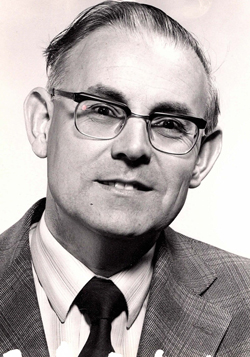Structural geologist who made a major impact on Scottish and Norwegian geology

Donald MacDonald Ramsay was born in Glasgow on 17 August 1932, but was evacuated during the Second World War to his uncle’s farm in Beauly, near Inverness. Donald returned to Glasgow with a scholarship to Allan Glen’s School, then studied geology at the University of Glasgow, under Professor T. N. George. In 1956, he became a Fellow of the Geological Society.
With the flamboyant Nicholas Rast as his supervisor, Donald mapped the Dalradian structure and metamorphism of Glen Lyon for his PhD, which he gained in 1959. This set life-long work in motion in structural geology, tectonics and engineering geology. After a year lecturing at the University of Glasgow, he went to the University of Dundee and rose to be Head of Department and Professor. He often recounted how Rast, on his first field check of Donald’s mapping, distastefully hurled his humble sandwich pack into the heather and produced a bulging lunch hamper of solid and liquid refreshment. He also claimed that, after living in Glasgow, it took two years in Dundee before he ceased to automatically take an umbrella out with him.
From Highlands to islands
At Dundee, Donald initially studied deformed pebbles in Devonian rocks in the Highland Boundary Fault, using experimental deformation of pebbles to deduce the movement of the fault. In the early 1960s, he quickly moved to geological mapping in Norway, in collaboration with the late Brian Sturt. Their research started on Sørøya island in Finnmark county, in the far north. One important result of this work was the discovery of a significant alkaline complex, including carbonatites, which was reported in a classic 1965 paper. Publications on the structural geology of parts of Sørøya had Donald as lead author. Structural and metamorphic studies on Magerøya island, where the North Cape is, then followed.
Donald’s last field trip to Norway, in the 1990s, also together with Sturt, was in the Vågå area, just south of the Trondheim Region. The topics of his last publications on Norwegian geology included: the Seiland Igneous complex (2006), the Kalak Nappe in Finnmark, and the identification of Gondwanan elements in the Caledonian nappes of Finnmark (both 2007), the latter of which he co-authored with Sturt. Together they made a major impact on Norwegian geology.
Strong collaborations
Although Donald’s Norwegian work is pre-eminent, he continued working on Scottish geology, usually with Sturt, in their 1977 study of the northeast Scottish Dalradian gneisses and the 1979 identification of the Banff nappe. Later, in collaboration with T. H. Torsvik, the trio used palaeomagnetism to identify major allochthonous movements, movements on faults and even during sedimentation, mainly in Norway, but with one 2007 account of Shetland.
Donald’s work was recognised in 1987 by election to the Royal Society of Edinburgh, but the Oxburgh Review of university geology departments resulted in the closure of the Dundee department. In 1989, Donald returned to the University of Glasgow as Chair, from which he retired in 1997. Donald was a piper, curler player, whisky connoisseur, Partick Thistle football fan, a raconteur, and a quiet humourist.
Donald died on 29 May 2022; his wife, Elma predeceased him. He leaves Pauline, Gillian, and Simon, and was a grandfather and great-grandfather.
By Bernard Elgey Leake and David Roberts